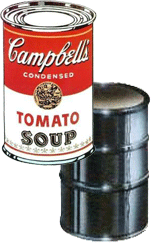|
|||||||||||||||||||||||||||||
As the linear dimension of an object varies, surface area varies according as the square while volume varies according as the cube.For example, this table shows the effects of doubling and halving the linear dimension...
For survival -- rather, for successful propagation of genes -- living things, over wide ranges in size from amoeba to arethusa, baboon to beetle,... zebra to zebu have each accommodated the Square-Cube Law through distinctive shapes and structures, tissues and organs. J. B. S. Haldane went on to observe size-imposed aspects of economic models and social institutions.
Not likely. Haldane's famous book, The Causes of Evolution (1932), a landmark work of modern evolutionary synthesis, applied the mathematics of Mendelian genetics to affirm Natural Selection. Accordingly, he would cheerfully regard the Tin-Can Mystery merely as evidence of "intelligent design." These 'species' did not take millions of years to evolve, guided by "selective pressure" in the Darwinian sense. Appearance of the tin-can dates back to only 1810 and its invention by Peter Durand. One must wonder at the rationale guiding the mind of the "intelligent designer," such that a height-to-diameter ratio of 1.5 seems to be appropriate across an 8-to-1 range in size. One obvious consideration is the cost
of materials. An
enclosed cylindrical container with diameter D
and height
H
has a surface area A =
|
 On
the
right, one sees two enclosed cylinders. Despite
their differences
in size, these containers are nearly the same shape,
with ratios of height-to-diameter
of 1.5. Linear dimensions vary between the two
containers by a factor
of eight (3.75 x 2.5 inches versus 30.25 x
20.0 inches). Thus, the
surface area of the oil barrel is 64 times
that of the soup can,
and the volume is 512 times more
capacious.
On
the
right, one sees two enclosed cylinders. Despite
their differences
in size, these containers are nearly the same shape,
with ratios of height-to-diameter
of 1.5. Linear dimensions vary between the two
containers by a factor
of eight (3.75 x 2.5 inches versus 30.25 x
20.0 inches). Thus, the
surface area of the oil barrel is 64 times
that of the soup can,
and the volume is 512 times more
capacious.
